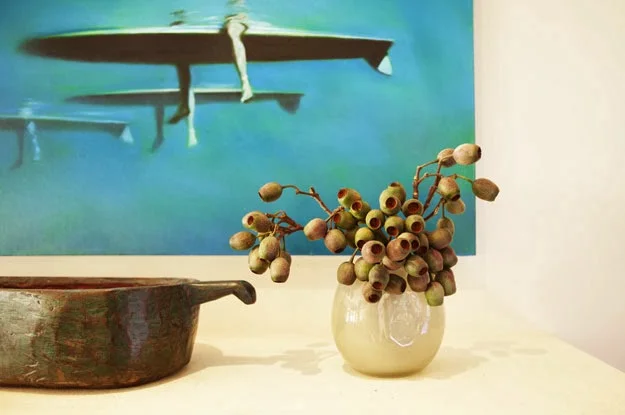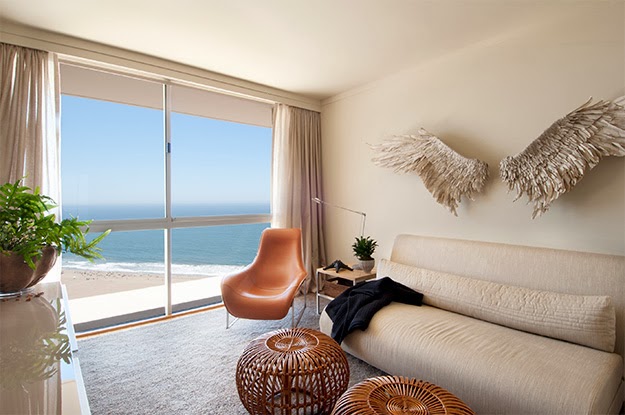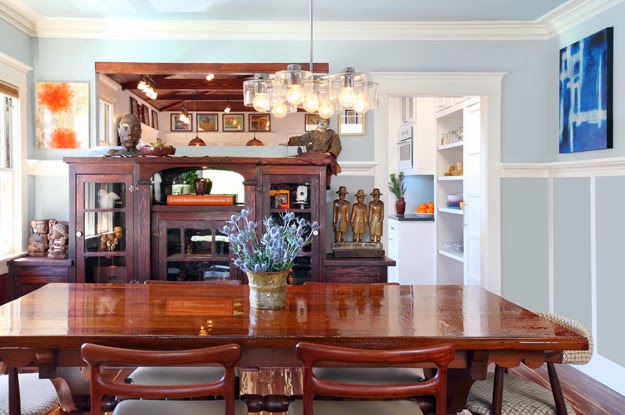Artistic Spaces: California Interior Design Style
/The earliest and most prominent role for art was the decoration of spaces and is still an everyday use for art. This is because its character and appearance profoundly influence our perception of a room. Very few of us would enjoy living and working in spaces devoid of decoration, no matter how nice the architecture. But despite the ubiquity of art in the areas that we inhabit, we are not always aware of its presence even as we are affected by it.
Some think, “To create a point of interest, merely hanging some wall art”. But frequently, the layout of a space is more comprehensive than we can immediately appreciate and can feature strategies other than simple ornamentation. The array of methods to integrate art into home design is more diverse than a viewer likely realizes, and extends well beyond a well placed potted plant. The design of the room can be the art itself.
The ocean view penthouse features artwork by Susan Hannon. In this room, a pair of handcrafted paper wings adorns the light sandy walls. They were designed to integrate in a precise way. Although similar in color, the wings emerge from the wall by their texture and the shadows that fall from their form. At a distance, this type of interruption on an otherwise smooth surface can be reminiscent of the impressionable shores of a beach, while the shape itself alludes to the lightness of flight and open spaces. This design approach is specific to the unit, a top floor penthouse with unobstructed views of the beach. Deeper connotations remain appropriate to the context. The wings, made of antique bible pages, allude to the story of Icarus and provide a clear parallel to the manufactured ascent afforded by the top floor in a modern building. It transforms the air in the space into a theme of the room. Even though these elements are not at once apparent, the careful coordination of artwork to an area can produce a powerful effect.
The artwork featured in the living room space of the Cosmopolitan Craftsman relates to the space more subtle ways. In the far right corner hangs a piece that is sourced directly from nature. It is a petrified fish slab, and its addition to the room acts as both an object of interest and an emphasis of the room’s color palette and cozy earthen aesthetic. Unlike the wings of the Penthouse, its presence does not directly influence the room but reinforces the design and feel of the space. The fireplace design is a less apparent artistic piece because it also serves a functional purpose. But beneath the umbrella of interior design, all elements in a space are united to convey a single theme or effect, and all objects in the room considered to be art. Interior design exists as a combination and balance of functionality and beauty. Like a painting or sculpture, a well-coordinated space can evoke from its viewer specific emotions and moods.
While the ocean view penthouse and the Cosmopolitan Craftsman utilize artwork to emphasize certain elements of design, the Landmark Bungalow dining room is utilized as a display for an eclectic collection of artwork. The large wooden cabinet serves as a showcase for various art pieces collected by the owner in his travels. The bust by Deborah Cansler Waters overlooks the vintage dining table. These elements were arranged to support the room's primary function as an area for people to gather, eat, and converse. The artwork provides context and stories for guests as it brings them and the space together in harmony. The vibrant blue painting on the far right by Lori Dorn compliments the effect.
It’s exciting to realize the rooms themselves can be art. Objects and spaces can serve a dual purpose, at once functional, and yet organized under ideas that are artistic rather than practical. An appreciation of the work of the interior designer leads to the satisfaction of the spaces we navigate daily, areas that constitute our context and contribute to our emotional state. Understanding that the feelings we have in a room are not accidental will lead to a greater appreciation of intelligent interior design.
Sarah Barnard designs healthy, happy, personalized spaces that are deeply connected to nature and art.
To learn more about Sarah Barnard Design, please visit www.SarahBarnard.com.







